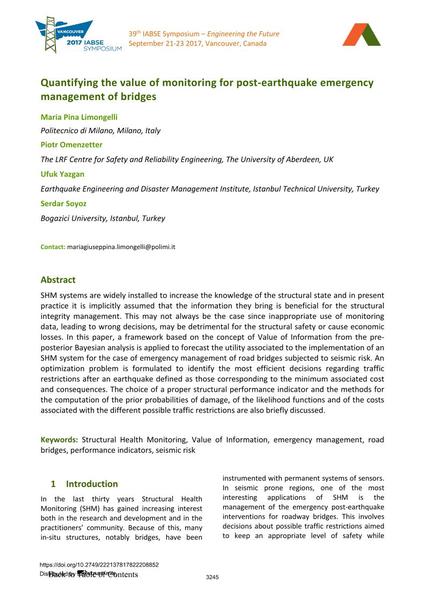Quantifying the value of monitoring for post-earthquake emergency management of bridges

|
|
|||||||||||
Détails bibliographiques
| Auteur(s): |
Maria Pina Limongelli
(Politecnico di Milano, Milano, Italy)
Piotr Omenzetter (The LRF Centre for Safety and Reliability Engineering, The University of Aberdeen, UK) Ufuk Yazgan (Earthquake Engineering and Disaster Management Institute, Istanbul Technical University, Turkey) Serdar Soyoz (Bogazici University, Istanbul, Turkey) |
||||
|---|---|---|---|---|---|
| Médium: | papier de conférence | ||||
| Langue(s): | anglais | ||||
| Conférence: | IABSE Symposium: Engineering the Future, Vancouver, Canada, 21-23 September 2017 | ||||
| Publié dans: | IABSE Symposium Vancouver 2017 | ||||
|
|||||
| Page(s): | 3245-3252 | ||||
| Nombre total de pages (du PDF): | 8 | ||||
| Année: | 2017 | ||||
| DOI: | 10.2749/222137817822208852 | ||||
| Abstrait: |
SHM systems are widely installed to increase the knowledge of the structural state and in present practice it is implicitly assumed that the information they bring is beneficial for the structural integrity management. This may not always be the case since inappropriate use of monitoring data, leading to wrong decisions, may be detrimental for the structural safety or cause economic losses. In this paper, a framework based on the concept of Value of Information from the pre- posterior Bayesian analysis is applied to forecast the utility associated to the implementation of an SHM system for the case of emergency management of road bridges subjected to seismic risk. An optimization problem is formulated to identify the most efficient decisions regarding traffic restrictions after an earthquake defined as those corresponding to the minimum associated cost and consequences. The choice of a proper structural performance indicator and the methods for the computation of the prior probabilities of damage, of the likelihood functions and of the costs associated with the different possible traffic restrictions are also briefly discussed. |
||||
| Mots-clé: |
ponts-routes
|
||||
